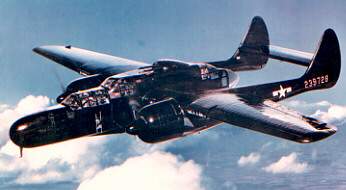| The events, by Ed Ruppelt, and a summary by professor James E. McDonald. | |
| The Fukuoka 1948 radar case, by Dr. James E. McDonald. | |
| The Fukuoka 1948 radar case, by Dr. J. Allen Hynek. |
In his book The Report on the Unidentified Flying Objects, 1955, Captain Ed Ruppelt, who was the head of Project Blue Book when it began, wrote:
Then [in 1948] radar came into the picture. For months the anti-saucer factions had been pointing their fingers at the lack of radar reports, saying, "If they exist, why don't they show up on radarscopes?" When they showed up on radarscopes, the UFO won some converts.
On October 15 [1948] an F-61, a World War II "Black Widow" night fighter was on patrol over Japan when it picked up an unidentified target on its radar. The target was flying between 5,000 and 6,000 feet and traveling about 200 miles per hour. When the F-61 tried to intercept it would get to within 12,000 feet of the UFO only to have it accelerate to an estimated 1,200 miles per hour, leaving the F-61 far behind before slowing down again. The F-61 crew made six attempts to close on the UFO. On one pass, the crew said, they did get close enough to see its silhouette. It was 20 to 30 feet long and looked "like a rifle bullet."
From USAF Project Bluebook files comes the material summarized here for this officially unidentified case involving airborne-radar and air-visual observation of an unconventional "bullet-shaped" object. At 11:05 p.m. LST, a USAF F-61 Black Widow fighter, with a crew of pilot and radar observer, flying near Fukuoka, obtained a radar pickup on an unknown target at an altitude of around 6000 feet, and an initial range of about 10 miles. The total encounter, occupying a period of about ten minutes, is too complex to describe in full detail here.
The Bluebook file is thick and contains a number of different intelligence reports that are not mutually compatible on certain quantitative details such as closure distances. Briefly, a total of six radar passes were made, and each time the F-61 closed to about 400 yards, the unknown accelerated suddenly from about 200 mph to an estimated 1200 mph.
The original report from Far East Air Forces intelligence sources states that the unknown "had a high rate of acceleration and could go almost straight up or down out of radar elevation limits. There was sufficient moonlight to permit a silhouette to be discerned although no details were observed". The F-61 crew thought it possible that the six passes might have been made on two separate unknowns, but this was inferential.
Another portion of the official file includes a FEAF follow-up report, describing some other points: "When the F-61 approached within 12,000 feet, the target executed a 180-degree turn and dived under the F-61. The F-61 attempted to dive with the target but was unable to keep pace. It is believed that the object was not lost from the scope due to normal skip null-zones common to all radar equipment. The pilot and observer feel that it was the high rate of speed of the object which enabled it to disappear so rapidly".
And still another document in the Bluebook file describes the visual sighting made at one juncture: "At the time of only visual sighting, target was on a level with observing aircraft. Under night visibility all that was visible was a silhouette. Type of tail stabilizers is unknown. General classification - very short body giving a stubby appearance. Canopy, if present, was formed into aircraft body to give the object clean-cut lines and was not discernible". The estimated size was 20-30 feet, and an accompanying sketch shows it as having a sharply cut-off tail ("bullet-shaped"). No exhaust was seen. The moon was nearly full on that night, and the airmen saw the outline against a moonlit cloud. USAF ground-radar stations at Shigamo-Shima and Fukae-Shima had the F-61 on their scopes intermittently as it moved in and out of ground clutter, but at no times obtained a radar-return from the unknown.
Ruppelt states that the Fukuoka sighting was one of the first UFO cases where an unidentified was seen on a radarscope; but many have since attained that distinction. Indeed, when one reads the full text of the 1953 Robertson Panel, one of the arresting points is the evident concern with the large number of radar fast-tracks already on record by that date. Despite the existence in USAF records of a number of unidentifieds seen on radar (often with both airborne and ground radar, and sometimes with ground- and air-visual sightings in accord), members of a Congressional Armed Services Committee investigation were told by the USAF Bluebook officer on April 5, 1966, that "we have no radar cases which are unexplained". This was in answer to Congressman Schweiker's pertinent question when the Committee was inquiring into the UFO problem following the 1966 Michigan "swamp gas" episode. Dr. J. Allen Hynek, Air Force scientific consultant for eighteen years and present in the hearing room, did not correct this misinformation.
The Black Widow was still used for a few years after WWII due to the USAAF's problems in developing a usable jet-powered all-weather night fighter. The Curtiss P-87 had initially been scheduled as the jet-powered replacement for the Black Widow, but the failure of the XP-87 project forced the Black Widow to have to soldier on for another few years. The last operational Black Widow left Japan in May 1950, missing the Korean War by only a month.

The best sources and references are provided in these pages, see the table of content at the top; for the original Project Sign reports and personal interviews you need to consult the Project Blue Book archive on location at NARA, Washington D.C., USA. (See www.archives.gov).